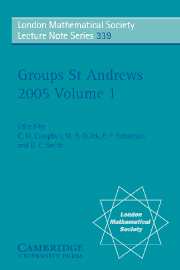Book contents
- Frontmatter
- Contents
- Introduction
- Aspects of infinite permutation groups
- Self-similarity and branching in group theory
- On surface groups: motivating examples in combinatorial group theory
- Nilpotent p-algebras and factorized p-groups
- Classification of finite groups by the number of element centralizers
- Algorithmic use of the Mal'cev correspondence
- Minimal but inefficient presentations for semi-direct products of finite cyclic monoids
- The modular isomorphism problem for finite p-groups with a cyclic subgroup of index p2
- On one-generated formations
- New results on products of finite groups
- Radical locally finite T-groups
- Explicit tilting complexes for the Broué conjecture on 3-blocks
- Conjugacy classes of p-regular elements in p-solvable groups
- An algorithm for the unit group of the Burnside ring of a finite group
- Integral group ring of the first Mathieu simple group
- Embedding properties in direct products
- Malcev presentations for subsemigroups of groups — a survey
- Finite groups with extremal conditions on sizes of conjugacy classes and on degrees of irreducible characters
- Conjugacy class structure in simple algebraic groups
- On automorphisms of products of groups
- Linear groups with infinite central dimension
- G-automata, counter languages and the Chomsky hierarchy
- An embedding theorem for groups universally equivalent to free nilpotent groups
- Irreducible word problems in groups
- Recent growth results
Self-similarity and branching in group theory
Published online by Cambridge University Press: 07 May 2010
- Frontmatter
- Contents
- Introduction
- Aspects of infinite permutation groups
- Self-similarity and branching in group theory
- On surface groups: motivating examples in combinatorial group theory
- Nilpotent p-algebras and factorized p-groups
- Classification of finite groups by the number of element centralizers
- Algorithmic use of the Mal'cev correspondence
- Minimal but inefficient presentations for semi-direct products of finite cyclic monoids
- The modular isomorphism problem for finite p-groups with a cyclic subgroup of index p2
- On one-generated formations
- New results on products of finite groups
- Radical locally finite T-groups
- Explicit tilting complexes for the Broué conjecture on 3-blocks
- Conjugacy classes of p-regular elements in p-solvable groups
- An algorithm for the unit group of the Burnside ring of a finite group
- Integral group ring of the first Mathieu simple group
- Embedding properties in direct products
- Malcev presentations for subsemigroups of groups — a survey
- Finite groups with extremal conditions on sizes of conjugacy classes and on degrees of irreducible characters
- Conjugacy class structure in simple algebraic groups
- On automorphisms of products of groups
- Linear groups with infinite central dimension
- G-automata, counter languages and the Chomsky hierarchy
- An embedding theorem for groups universally equivalent to free nilpotent groups
- Irreducible word problems in groups
- Recent growth results
Summary
Introduction
The idea of self-similarity is one of the most basic and fruitful ideas in mathematics of all times and populations. In the last few decades it established itself as the central notion in areas such as fractal geometry, dynamical systems, and statistical physics. Recently, self-similarity started playing a role in algebra as well, first of all in group theory.
Regular rooted trees are well known self-similar objects (the subtree of the regular rooted tree hanging below any vertex looks exactly like the whole tree). The self-similarity of the tree induces the self-similarity of its group of automorphisms and this is the context in which we talk about self-similar groups. Of particular interest are the finitely generated examples, which can be constructed by using finite automata. Groups of this type are extremely interesting and usually difficult to study as there are no general means to handle all situations. The difficulty of study is more than fairly compensated by the beauty of these examples and the wealth of areas and problems where they can be applied.
Branching is another idea that plays a major role in many areas, first of all in Probability Theory, where the study of branching processes is one of the main directions.
The idea of branching entered Algebra via the so called branch groups that were introduced by the first author at the Groups St Andrews Conference in Bath 1997.
Branch groups are groups that have actions “of branch type” on spherically homogeneous rooted trees.
- Type
- Chapter
- Information
- Groups St Andrews 2005 , pp. 36 - 95Publisher: Cambridge University PressPrint publication year: 2007
- 16
- Cited by



